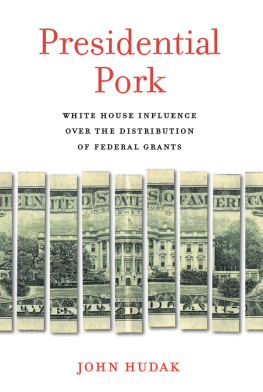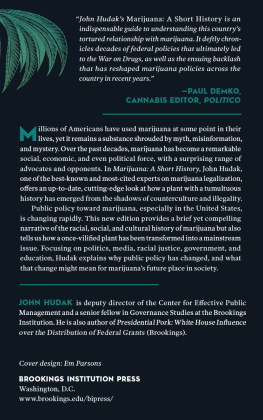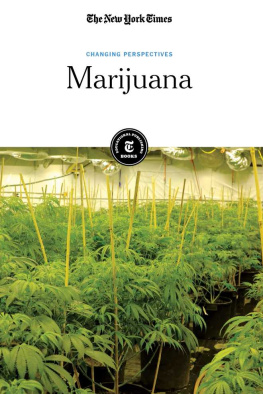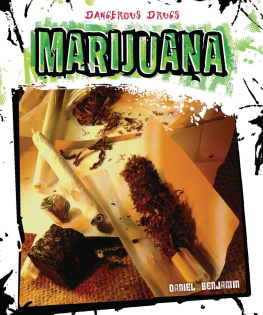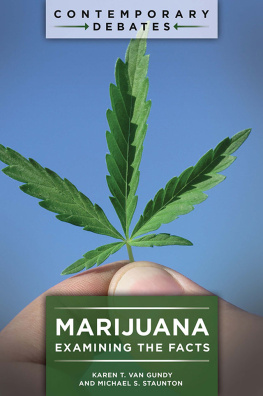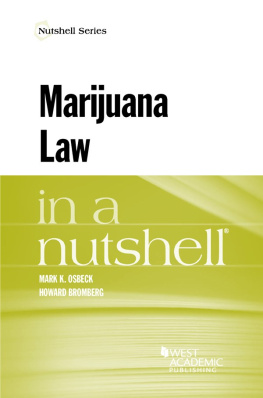A SHORT HISTORY
MARIJUANA
John Hudak
BROOKINGS INSTITUTION PRESS
Washington, D.C .
Copyright 2016
THE BROOKINGS INSTITUTION
1775 Massachusetts Avenue, N.W., Washington, D.C. 20036
www.brookings.edu
All rights reserved. No part of this publication may be reproduced or transmitted in any form or by any means without permission in writing from the Brookings Institution Press.
The Brookings Institution is a private nonprofit organization devoted to research, education, and publication on important issues of domestic and foreign policy. Its principal purpose is to bring the highest quality independent research and analysis to bear on current and emerging policy problems. Interpretations or conclusions in Brookings publications should be understood to be solely those of the authors.
Library of Congress Cataloging-in-Publication data are available .
ISBN 9-780-8157-2906-8 (pbk : alk. paper)
ISBN 9-780-8157-2907-5 (ebook)
9 8 7 6 5 4 3 2 1
Typeset in Sabon
Composition by Westchester Publishing Services
For Michelle Dean
CONTENTS
ACKNOWLEDGMENTS
WORKING ON MARIJUANA reform was one of the last things I expected would be part of my career when I began doing political and policy research. I am not an advocate; I am a political scientist. I was not trained in the study of drug policy; I was trained in the study of political institutions, specifically the presidency and the bureaucracy.
However, sometimes very interesting opportunities fall into your lap, and a new venture becomes a career highlight. Marijuana policy is exactly that. I came to this issue in part by happenstance and largely because a colleague of mine, Jonathan Rauch, encouraged me to ask the types of questions my research focuses on (regulation, personnel, bureaucratic organization, and executive-legislative interaction) and apply it to a new and emerging area of policy: the legalization of adult-use marijuana.
That spurred an interest in marijuana policy of all types and led to extensive research, many trips and interviews, as well as a nearly obsessive reading into the plant, its products, the people, and the policy. Along the way, I worked with a tremendous group of individuals who approach this issue from all directionsfrom the full-throated advocate to the staunchest of opponents and everyone in between. Their support, guidance, knowledge, experience, personal stories, and perspectives have helped inform my understanding of marijuana policy and made Marijuana: A Short History what it is.
Chief among all of the people with whom I have worked is my former colleague and frequent coauthor, Grace Wallack. Grace has an incredible mind for whatever endeavor she undertakes. As in my case, marijuana policy was not a lifelong passion or expected part of her job, but as a team we picked apart some of the most complex issues surrounding marijuana policy and sought to explain them to whomever would listen. It turned out, a lot of people listened. Without her support, intellect, motivation, and ability to keep me on track, the marijuana research emerging from my office would have been a shell of what it is today. She deserves both the highest of praise and my complete gratitude.
Other Brookings colleagues have helped inform my work, my understanding of marijuana policy, and were excellent sounding boards as this book came to fruition. Phil Wallach, Jon Rauch, Ashley Gabriele, the Brookings Creative Lab Team (George Burroughs, Sareen Hairabedian, Mark Hoelscher, Zach Kulzer, Ian McAllister), Ashley Bennett, Jessica Brandt, Bob Brier, Brittany Brown-Hart, Stephanie Dahle, Courtney Dunakin, Anna Goodbaum, Christine Jacobs, Dylan Jennings, Ellie Klein, Curtlyn Kramer, Nick McClellan, Cody Poplin, Camilo Ramirez, Liz Sablich, Beth Stone, Strobe Talbott, Liz Thom, and Nick Zeppos. Each deserves my thanks.
Outside of Brookings, a number of peopletoo many to list completelyhave been hugely influential and helpful to me. They include Barb Brohl, Jonathan Caulkins, Mike Collins, Beth Collins and Pat Collins and their daughter, Jennifer Collins, Michael Correia, Sean Easter, Brian Faughnan, Steve Fox, Andrew Freedman, Alison Holcomb, Jeff Kahn, Ron Kammerzell, Beau Kilmer, Mark Kleiman, Blake Komar, Lewis Koski, Miles Light, Stephanie Phillips, Dan Riffle, Kevin Sabet, Steph Sherer, Sue Sisley, Sarah Trumble, John Walsh, and Jeff Zinsmeister.
In addition, I would like to thank my colleagues Bill Brown, Rob Lang, and the entire Brookings Mountain West and UNLV community, as well as, Congressman Earl Blumenauer, and my favorite Nevada state senators, Patricia Farley and Tick Segerblom.
Finally, to all the elected officials, law enforcement, doctors, scientists, activists (on both sides), academics, growers, dispensary owners, marijuana industry employees, and regulators, a huge thank you for opening your doors and letting me in to see exactly what the cannabis world looks like from your point of view. The many people involved in this policy space whom I have visited in Alaska, California, Colorado, Connecticut, the District of Columbia, Nevada, Ohio, and Washingtonthank you for your generous offer of time and insight.
A huge thank you goes to the Brookings Institution Press, especially Bill Finan, Valentina Kalk, Janet Walker, and Carrie Engel.
Finally, a special note of gratitude goes to my wife, Emily Parsons. Em is a woman with unending patience, listening to me drone on endlessly about pot for months and now years. Her motivation and encouragement through this projectlike all projectshave ensured that I am nearly as proud of this book as I am of her each day. She deserves both my love and gratitude.
INTRODUCTION
MARIJUANA IS NOT NEW. For millennia, humans have used the cannabis plant for medicine, recreation, religious purposes, and food. The fibers of some cannabis plants, also called hemp, have been used to make rope and textiles. The drug that is made from the plant has also led to the expansion of government power, the imprisonment of hundreds of thousands of individuals, wars waged between nations, and the vilification of some racial and ethnic groups.
Now marijuana has gone mainstream, becoming a relevant part of American public policy debates. Medical and recreational use of marijuana has become an increasingly legitimate and accepted practice in the United States and other nations.
Marijuana has had a long and storied past. This short history is not an exhaustive account of humankinds relationship with the planta relationship believed to be at least 5,000 years old. Instead, it focuses on marijuana policy in the United States. Although at one time unregulated, openly used, and readily prescribed by physicians for the treatment of countless conditions, Americas experience with marijuana has been rocky, evolving, and unpredictable. Today, marijuana and the public policy issues it raises are more important than ever.
As of summer 2016, twenty-five states and the District of Columbia had legalized marijuana for medical use. Four states and the District of Columbia had legalized marijuana for recreational use. Numerous states, counties, and municipalities had decriminalized marijuana and its derivatives. Every year legislative proposals are filed in the U.S. Congress that engage the issue. Marijuanas changing policy space has even gained responses from federal courts, the White House, the Department of Justice, the Department of Health and Human Services, and the U.S. Treasury.
New state-level ballot initiatives to legalize the use of marijuana are launched every year, and legalization proposals have and will continue to produce serious debates on the floors of state legislatures. Legalized medical and recreational marijuana are certain to be part of Americas future, and so it is essential to understand the history of marijuana policy in the United States.
Next page

